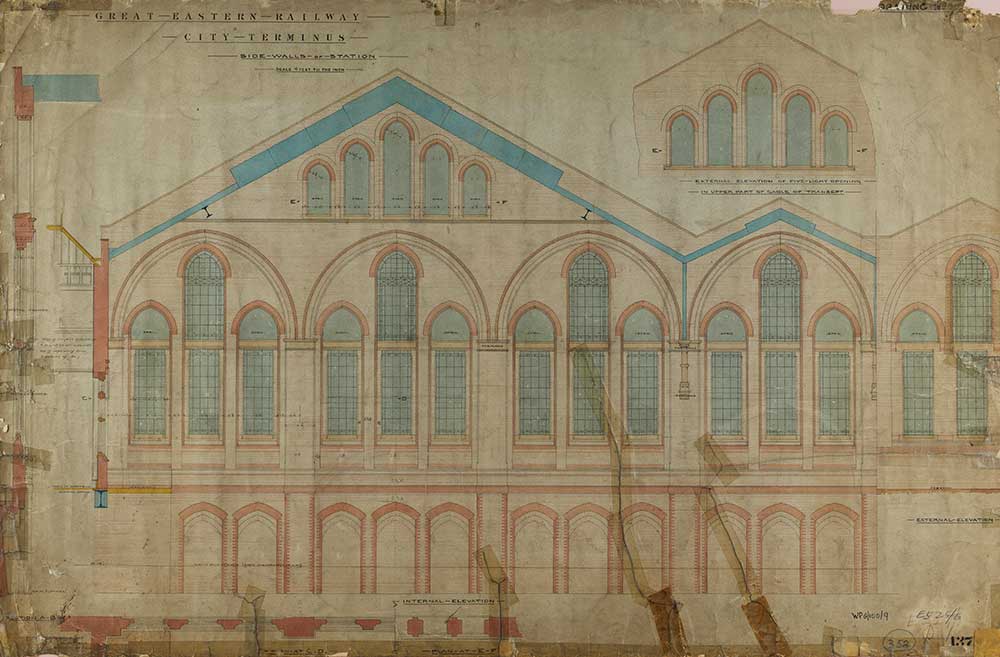The history of London Liverpool Street station
Liverpool Street has a reputation as a bustling commuter station having been built in the City of London.
However, its Great Eastern lines also take passengers to holiday destinations and historical towns in the east of England. Once called the ‘dark cathedral’, Liverpool Street is now the busiest station in Britain following the opening of the Elizabeth line in May 2022.

Image credit: Science Museum Group
A new station for the City
When the Great Eastern Railway was formed in 1862 it quickly drew up plans for a new terminus in the heart of the City of London. It had inherited the nearby Bishopsgate station in Shoreditch from the Eastern Counties Railway, but this wasn’t big enough or convenient enough for the City commuters it hoped to attract.
It gained authorisation for an extension of the line from Bishopsgate to a new terminus just inside the City boundaries, and next door to the North London Railway’s Broad Street station. Broad Street station had been built on a high level on a viaduct. The Great Eastern Railway chose to do the opposite, taking the station to a low level below the street in an effort to join with the Metropolitan Railway.
The dark cathedral
The first suburban trains departed from a partially completed Liverpool Street station in 1874. The terminus’ ten platforms and completed station opened fully in 1875 and the old Bishopsgate station was closed and turned into a goods yard.
The station was designed by the company’s engineer Edward Wilson in an L shape with suburban services operating from the shorter platforms, mainline services from the longer ones. The station also had offices for the Great Eastern Railway built into the scheme.
The trainshed was tall and built of wrought iron and glass, its transept over the suburban lines immediately giving the station a cathedral like quality.
Over the next ten years demand for services, especially suburban commuter trains into the City from north east London, soon outstripped capacity at the station. The GER acquired more land and extended the station to the east. This east side extension opened in 1894 and added eight new platforms housed under a much plainer trainshed roof.
Commuter services
Throughout the early twentieth century the Great Eastern Railway at Liverpool Street built up a steady and solid commuter base. It did look into the possibilities of electrification, which was bringing increased capacity to other London stations, but it could not afford to invest.
With no further room to expand its station, the Great Eastern, and its successor the London & North Eastern Railway, concentrated on developing and increasing its suburban steam services, a business model that continued until steam was withdrawn in the 1960s. Under its modernisation plan, British Railways electrified all suburban services running from Liverpool Street station, and all steam had been replaced by diesel locomotives by the end of 1962.
A new Liverpool Street
By the 1970s, Liverpool Street was not what it once was. But it was about to get a new lease of life.
The building of the eastern extension in 1894 had created a station divided in two and connected by a footbridge. Coming up to a century later, this arrangement was confusing, led to congestion and prevented the station from providing modern facilities.
In the meantime, Broad Street station next door was a shadow of its former self. It had once been London’s third busiest station, but by 1983 it was used by only 3,300 passengers a day.
As a result, the decision was made to demolish Broad Street and replace it with offices, shops and public spaces. The 1894 eastern extension roof was demolished too, with new offices being built above the platforms instead.
Meanwhile, the money raised from the property development was used to revamp Liverpool Street station. Work started in 1985 and the station you see today, with its two halves brought together into a single concourse, was opened by Her Majesty Queen Elizabeth II in December 1991.
The Elizabeth line
At the end of 2023, Liverpool Street was named as the new busiest station in Britain, with 80.4 million passenger entries and exits in the space of a year.
The big increase from the previous results was put down to the opening of the Elizabeth line, with Liverpool Street being a major interchange on the new service.
150 and beyond
Liverpool Street turns 150 years old during 2024 and ambitious upgrades are planned to keep improving the station ready for the generations to come.
Did you know?
Liverpool Street is named after the British Prime Minister Lord Liverpool.